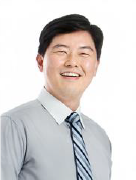Prof. Taesung Kim
School of Mechanical Engineering and SKKU Advanced Institute of Nanotechnology, Sungkyunkwan University
Abstract: As the semiconductor device is shrinking and gets complicated, the chemical mechanical polishing (CMP) process has become important. Various types of abrasive particles are used as CMP slurry, and among them, ceria slurry is in the spotlight due to its high material removal rate (MRR) and selectivity on oxide CMP process. It is known that the ceria abrasives form Ce-O-Si chemical bonds with oxide film, which makes it possible to achieve a high CMP performance.
To further advance the performance of ceria slurry, we conducted a series of researches on ceria. A study was conducted on scanning mobility particle sizer (SMPS) measurement to accurately evaluate particle size distribution along with the basic polishing mechanism of monodisperse ceria nanoparticles. In addition, an optimization study was conducted considering the CMP performance according to the abrasive concentration of ceria slurry and the influence of ceria nanoparticles remaining on the wafer surface before the post-CMP cleaning process. Furthermore, research on synthesis method and surface modification of ceria was also conducted to improve the polishing performance. Ce3+ ions on the surface of ceria form Ce-O-Si chemical bond with the silicon dioxide film. Therefore, an important key point is to increase the concentration of Ce3+ ions to improve polishing performance. To achieve high Ce3+ ion concentration, ceria nanoparticles were synthesized through a hydrothermal method, and this performance was improved through lanthanide doping. On the other hand, methods to enhance Ce3+ ion concentration by inducing a reduction reaction on the surface of ceria nanoparticles were also proposed. First, the polishing performance was improved by adding trace metals (FeCl2, CrCl2) to induce a reduction reaction of ceria nanoparticles. Next, the reduction reaction of ceria was induced by applying an eco-friendly method which did not add chemical agents. Ultraviolet (UV) irradiation and hydrogen-gas reduction methods showed sufficient reduction reaction to improve the polishing performance of ceria slurry, and maintained physical properties without causing CMP defects such as poor surface roughness and micro-scratches.
As with previous polishing studies, post-CMP cleaning is also important to decease defects. While ceria nanoparticles exhibit great polishing performance for silicon dioxide due to their ability to form chemical bonds, however, they also have the disadvantage of being difficult to remove during the post-CMP cleaning process. To efficiently remove ceria nanoparticles from the wafer surface during the post-CMP cleaning process, various methods have been studied. First, the buff cleaning process was studied in which a deionized water-based cleaning solution is injected instead of slurry after the CMP process. Since the buff cleaning process must simultaneously minimize damage of wafer surface and maximize cleaning performance, optimization research on the properties of the physical factors and cleaning solution is important. For an environmentally friendly cleaning method, we proposed controlling the viscosity of deionized water or using gas-dissolved water. It has been proven that physical factors of cleaning solutions (viscosity, microbubbles, etc.) can be effective in removing ceria nanoparticles. Especially, hydrogen gas in gas-dissolved water induced a reduction reaction, breaking Ce-O-Si bonds and improving the cleaning performance. Limited to the bulk ceria CMP process, we also studied the improvement of cleaning performance of remained ceria nanoparticles using the tangential flow filtration (TFF) method before CMP process. We focused that small contaminant particles are difficult to remove during the cleaning process, and through the TFF method, small abrasive particles in the slurry are filtered in advance while maintaining the polishing performance.
Friday, August 09, 2024, at 03:30 pm
CAMP 372

Bio: Dr. Taesung Kim received his Bachelor’s in Mechanical Engineering from Seoul National University, Korea in 1994. He received his Master’s, and Ph. D. in Mechanical Engineering from University of Minnesota, USA in 1998 and 2002, respectively, focusing on particle and aerosol research. He joined Seagate Technology in 2002 and worked as Senior and Staff Engineer in Recording Head R&D.
Since 2005 Dr. Kim has been a professor in the School of Mechanical Engineering and SKKU Advanced Institute of Nanotechnology (SAINT), Sungkyunkwan University in Suwon, Korea. In 2014, he was appointed as SKKU Young Fellow and started to work for SKKU Research & Business Foundation as a Vice President. Presently, he is in charge of Office of Admissions in SKKU. His research interests include 2-D material synthesis, optical fiber sensors, semiconductor/display manufacturing process (CMP, cleaning and contamination control), and atmospheric/indoor aerosol control.